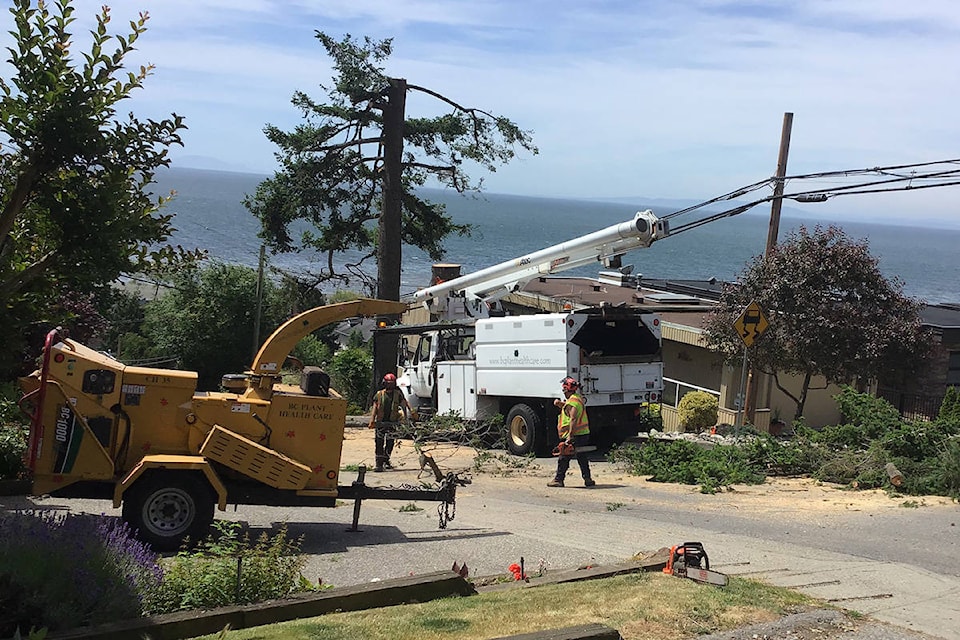White Rock is taking a look at creating a stringent new bylaw designed to protect the city’s tree canopy.
A draft tree protection bylaw – prepared to incorporate recommendations of the city’s environmental advisory committee – came before council during its Feb. 22 online meeting.
Coun. Erika Johanson, the council representative on the committee, explained that the recommendations in the draft bylaw, which – if adopted – would replace the city’s current tree bylaw, are an attempt to address what has been a “serious decline in White Rock’s tree canopy over the last two decades.”
There is a need, she said, to remedy a decision-making process and city policies that have allowed private property owners and developers – and even city contractors – to extensively prune trees or remove them entirely, without direct consultation with council.
READ ALSO: Tree clearing in uptown White Rock surprises, angers
The overriding purpose of the recommendations, she said, is “to protect trees – rather than just manage the way in which they may be removed.”
Council unanimously endorsed a motion to refer half of the recommendations to the government and legislation committee.
These include reducing the minimum size for a protected tree; establishing a definition of ‘significant trees’ on private or city lands; removing fruit trees, alders and cottonwoods from a definition of ‘lower value’ trees; and enlarging the use of tree replacement security and deposit charges.
Also referred to the governance and legislation committee are measures requiring 14 days’ notice of removal of a city tree to property owners within 100 metres; establishing International Society of Arboriculture certification as the qualifying criteria for arborists; requiring city arborists to visit all sites under consideration for a tree permit, establishing explicit criteria for granting permits; requiring any removal or planting of trees on city lands to be done by city staff or contractors, and changing city policy language and limiting the criteria under which trees could be pruned, thinned or reduced in width in cases where it can be demonstrated that the tree has grown to completely obscure a previously existing view.
Council also approved a motion to refer the other half of the recommendations to city staff for a report on ways in which such policy changes can be put into effect – including suggestions that would give tree preservation and canopy enhancement more priority in zoning and planning regulations; setting canopy recovery targets, maintaining records of contractors who have contravened city bylaws; and establishing annual tree canopy reports to council.
Johanson explained the move to create a new bylaw, and revise city tree policy, was directly inspired by the felling of two 100-foot Douglas Fir trees on Oxford Street in June of 2019.
READ ALSO: ‘Eagle trees’ on White Rock’s Oxford Street felled Thursday
“Council was only notified after the work had started,” she said – which raised concerns among the current members (a majority of whom, like herself, had been first elected the previous October).
“Council raised questions about the process of tree management decision-making – specifically that council needs to be consulted before removing trees,” Johanson said.
As a result, she said, the governance and legislation committee referred the tree management bylaw governing private property, and the tree management policy regulating trees on city lands, to the environmental advisory committee.
A thorough review has resulted in 19 concrete recommendations, she said, which are now included in the draft bylaw.
One of the most important findings of the committee, she said, is recognition that most of the city’s tree canopy loss is a result of private development.
“The challenge of protecting trees cannot be met by bylaw and policy alone. We need to look, perhaps, above all at GPA guidelines, zoning regulations and their related policies.”
Johanson said the EAC also recommends “clearer and stronger statements of purpose” in zoning and development permit applications so that tree protection is evaluated in the same way as environmental impacts.
alex.browne@peacearchnews.com
Like us on Facebook and follow us on Twitter
